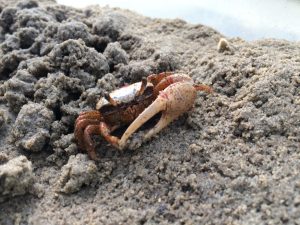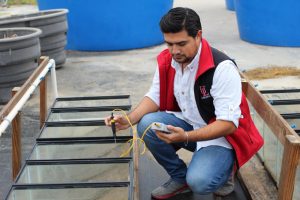Study Finds Oil Impacts on Fiddler Crabs May Also Affect Broader Marsh Health
– JULY 2, 2019
Scientists conducted mesocosm experiments to explore how crude oil affects marsh-dwelling fiddler crabs, classified as ecosystem engineers or bioturbators. The researchers tested impacts of various oil concentrations to mimic light (L) to heavy (H) oiling scenarios, with fiddler crabs experiencing more acute impacts at higher oil concentrations and less at lower concentrations. Compared to controls, oil exposure was associated with fiddler crabs that delayed their burrowing activities, built smaller (L 13% – H 22%) and shallower (L 11% – H 31%) burrows, and transported less sediment (L 24% – H 41%). Their digestive gland (hepatopancreas) had increased oxidative stress (L 35% – H 196%), perhaps from detoxification mechanisms involved in breaking down oil compounds, and there was up to a three-fold increase in blister cells (release digestive enzymes). The results suggest that oil impacts on fiddler crabs may have implications for other species that depend on them for food or ecological changes from their burrowing.
The researchers published their findings in Environmental Toxicology and Chemistry: Crude oil toxicity to fiddler crabs (Uca longisignalis and Uca panacea) from the northern Gulf of Mexico: Impacts on bioturbation, oxidative stress, and histology of the hepatopancreas.
Impacts of off-shore oil spills are not limited to the open ocean. Surface and below-surface currents along with wind and waves can move oil onshore where it can disturb coastal communities and ecosystems. This was the case during Deepwater Horizon, and there was great concern for coastal marine life and the seafood industry. There was also concern for species further down the food chain like fiddler crabs, who help maintain marsh soils, sediments, and food webs. Their normal burrowing activities modify sediment’s biogeochemical processes such as increasing oxygenation and drainage, enhancing organic matter decomposition, and redistributing nutrients.
“Smaller organisms are vital for many important species to thrive such as blue crab, fish, birds, and mammals; therefore, these small organisms are needed for a fully-functioning ecosystem,” explained study author Marco Franco. “Many large fish and birds feed on fiddler crabs and other abundant small animals. Our study focuses on oil spill effects on fiddler crabs because impacts on them can have cascading consequences for the entire ecosystem.”
After the oil spill, scientists reported reductions in fiddler crabs’ burrow densities, changes in species composition, and decreased burrow diameters (Estuaries and Coasts Zengel et al., 2016). However, insights into the oil’s effects were limited because of challenges controlling field variables and limited pre-spill information on fiddler crab populations. This study sought to bridge that research gap by conducting more-controlled mesocosm experiments using fiddler crabs collected from Elmer’s Island and Grand Isle State Park in Grand Isle, Louisiana. The team provided multiple lines of evidence, from molecular and cellular disruptions to behavioral alterations, to strengthen study results.
“Mesocosms are the mid-point between full field studies and laboratory experiments, so it is possible to control and manipulate different environmental variables while keeping the usual characteristics of coastal ecosystems,” explained Franco. “The study used a variety of methodologies, ranging from measuring burrows made by the fiddler crabs to counting specific types of tissue cells. We also used painted sediment particles (luminophores) to measure how much and how fast the fiddler crabs were burrowing.”
Oil concentrations (using Louisiana Sweet crude oil) ranged from 0 to 55 mg oil/cm2 of sediment surface in the mesocosms and microcosms. “The doses selected aimed to be representative of the shoreline oiling following the Deepwater Horizon oil spill,” explained Franco. “The concentrations used ranged from “lightly oiled” to “heavily oiled” (terminology used for assessing impacts), thus mimicking oiling levels that were observed on the Gulf of Mexico coast following the spill. By using these doses, we evaluated best- and worst-case scenarios for the toxicological and behavioral responses of oil-exposed crabs. For a clear understanding of the implications of oil spills, it is important to assess effects over a broad range of oiling severity.”
The different responses from the two fiddler crab species (one was more sensitive to oil than the other) suggests that oil exposure could lead to species composition changes, which was documented after the spill (Marine Ecology Progress Reports Zengel et al., 2016).
“The study shows that even when oil exposure is not bad enough to kill animals like fiddler crabs, it can affect their health and their burrowing activity,” said Franco. “The results suggest that disturbance to these and other ecosystem engineers will in turn affect multiple processes that keep coastal ecosystems running. If fiddler crab populations decline or even when they survive but become less active, this is likely to have a negative impact on marsh health. Our results open questions about other organisms that interact with and depend on fiddler crabs, and how they may be affected if fiddler crabs are disturbed.”
Data are publicly available through the Gulf of Mexico Research Initiative Information and Data Cooperative (GRIIDC) at doi:10.7266/N76Q1VNR.
The study’s authors are Marco E. Franco, Bruce E. Felgenhauer, and Paul L. Klerks.
By Nilde Maggie Dannreuther. Contact maggied@ngi.msstate.edu with questions or comments.
************
This research was made possible in part by a grant from the Gulf of Mexico Research Initiative (GoMRI) to the University of Louisiana Lafayette for the project The Effect of Sediment Bioturbators on the Biological Degradation of Petroleum in Coastal Ecosystems.
The Gulf of Mexico Research Initiative (GoMRI) is a 10-year independent research program established to study the effect, and the potential associated impact, of hydrocarbon releases on the environment and public health, as well as to develop improved spill mitigation, oil detection, characterization and remediation technologies. An independent and academic 20-member Research Board makes the funding and research direction decisions to ensure the intellectual quality, effectiveness and academic independence of the GoMRI research. All research data, findings and publications will be made publicly available. The program was established through a $500 million financial commitment from BP. For more information, visit https://gulfresearchinitiative.org/.
© Copyright 2010-2019 Gulf of Mexico Research Initiative (GoMRI) – All Rights Reserved. Redistribution is encouraged with acknowledgement to the Gulf of Mexico Research Initiative (GoMRI). Please credit images and/or videos as done in each article. Questions? Contact web-content editor Nilde “Maggie” Dannreuther, Northern Gulf Institute, Mississippi State University (maggied@ngi.msstate.edu).







